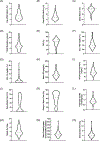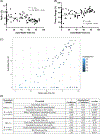Increased proportion of time in hybrid closed-loop "Auto Mode" is associated with improved glycaemic control for adolescent and young patients with adult type 1 diabetes using the MiniMed 670G insulin pump
- PMID: 31709736
- PMCID: PMC7549138
- DOI: 10.1111/dom.13912
Increased proportion of time in hybrid closed-loop "Auto Mode" is associated with improved glycaemic control for adolescent and young patients with adult type 1 diabetes using the MiniMed 670G insulin pump
Abstract
The Medtronic MiniMed 670G system delivers insulin to patients with type 1 diabetes mellitus (T1DM) using either its hybrid closed-loop (HCL) "Auto Mode" feature or an open-loop mode. In this retrospective, cross-sectional analysis, we quantified the association between time in Auto Mode and both haemoglobin A1c (HbA1c) and time in range (TIR, sensor glucose 70-180 mg/dL) among 96 paediatric and young adult patients with T1DM. The median percentage time in Auto Mode was 38.5% (interquartile range 0%-64%). The percentage time in Auto Mode significantly correlated with HbA1c after adjustment for covariables (β = -0.008, P = 0.014). Each daily 3.4-h increase in Auto Mode time was associated with a 0.1% decrease in HbA1c. Auto Mode time was also correlated with TIR after adjustment for covariables (β = 0.14, P = 0.02): for each daily 8.6-h increase in Auto Mode time, TIR increased by 5%. While Auto Mode use was low, increased time in Auto Mode was associated with a significantly lower HbA1c and increased TIR. These findings emphasize the importance of identifying strategies to improve the ease of use of HCL systems.
© 2019 John Wiley & Sons Ltd.
Conflict of interest statement
CONFLICT OF INTEREST
The authors have no conflict of interest to report.
Figures


Similar articles
-
Retrospective Analysis of 3-Month Real-World Glucose Data After the MiniMed 670G System Commercial Launch.Diabetes Technol Ther. 2018 Oct;20(10):689-692. doi: 10.1089/dia.2018.0202. Epub 2018 Aug 30. Diabetes Technol Ther. 2018. PMID: 30160523
-
One-year experience of hybrid closed-loop system in children and adolescents with type 1 diabetes previously treated with multiple daily injections: drivers to successful outcomes.Acta Diabetol. 2021 Feb;58(2):207-213. doi: 10.1007/s00592-020-01607-4. Epub 2020 Oct 12. Acta Diabetol. 2021. PMID: 33044604 Free PMC article.
-
Switching from Suspend-Before-Low Insulin Pump Technology to a Hybrid Closed-Loop System Improves Glucose Control and Reduces Glucose Variability: A Retrospective Observational Case-Control Study.Diabetes Technol Ther. 2020 Apr;22(4):321-325. doi: 10.1089/dia.2019.0302. Epub 2020 Feb 11. Diabetes Technol Ther. 2020. PMID: 31617752
-
Commercial hybrid closed-loop systems available for a patient with type 1 diabetes in 2022.Pediatr Endocrinol Diabetes Metab. 2023;29(1):30-36. doi: 10.5114/pedm.2023.126359. Pediatr Endocrinol Diabetes Metab. 2023. PMID: 37218723 Free PMC article. Review.
-
INTEGRATED INSULIN PUMP AND CONTINUOUS GLUCOSE MONITORING TECHNOLOGY IN DIABETES CARE TODAY: A PERSPECTIVE OF REAL-LIFE EXPERIENCE WITH THE MINIMED™ 670G HYBRID CLOSED-LOOP SYSTEM.Endocr Pract. 2018 Jul;24(7):684-692. doi: 10.4158/EP-2018-0097. Endocr Pract. 2018. PMID: 30048171 Review.
Cited by
-
Real-World Patient-Reported Outcomes and Glycemic Results with Initiation of Control-IQ Technology.Diabetes Technol Ther. 2021 Feb;23(2):120-127. doi: 10.1089/dia.2020.0388. Epub 2020 Sep 10. Diabetes Technol Ther. 2021. PMID: 32846114 Free PMC article.
-
A Pilot Study of Youth With Type 1 Diabetes Initiating Use of a Hybrid Closed-Loop System While Receiving a Behavioral Economics Intervention.Endocr Pract. 2021 Jun;27(6):545-551. doi: 10.1016/j.eprac.2020.11.017. Epub 2020 Dec 15. Endocr Pract. 2021. PMID: 34120699 Free PMC article.
-
A comparison of two hybrid closed-loop systems in adolescents and young adults with type 1 diabetes (FLAIR): a multicentre, randomised, crossover trial.Lancet. 2021 Jan 16;397(10270):208-219. doi: 10.1016/S0140-6736(20)32514-9. Lancet. 2021. PMID: 33453783 Free PMC article. Clinical Trial.
-
Closed-Loop Insulin Therapy Improves Glycemic Control in Adolescents and Young Adults: Outcomes from the International Diabetes Closed-Loop Trial.Diabetes Technol Ther. 2021 May;23(5):342-349. doi: 10.1089/dia.2020.0572. Epub 2021 Jan 21. Diabetes Technol Ther. 2021. PMID: 33216667 Free PMC article. Clinical Trial.
-
A Randomized Trial of Closed-Loop Control in Children with Type 1 Diabetes.N Engl J Med. 2020 Aug 27;383(9):836-845. doi: 10.1056/NEJMoa2004736. N Engl J Med. 2020. PMID: 32846062 Free PMC article. Clinical Trial.
References
-
- Stone MP, Agrawal P, Chen X, et al. Retrospective analysis of 3-month real-world glucose data after the MiniMed 670G system commercial launch. Diabetes Technol Ther. 2018;20:689–692. - PubMed
-
- Miller KM, Foster NC, Beck RW, et al. Current state of type 1 diabetes treatment in the U.S.: updated data from the T1D Exchange Clinic Registry. Diabetes Care. 2015;38:971–978. - PubMed
Publication types
MeSH terms
Substances
Grants and funding
LinkOut - more resources
Full Text Sources
Medical

